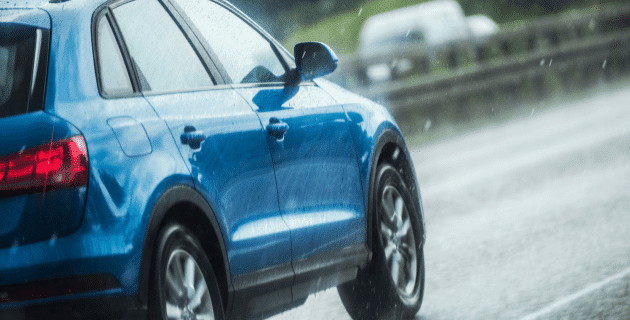From hail to high winds, flooding, and more, spring storms can do some real damage — and not just to your home and property. These intense storms can also take their toll on your car.
Here are some ways you can protect your vehicle from spring storms.
Take cover – and cover-up — during hailstorms.
Hailstorms do billions of dollars of damage each year, according to the Insurance Information Institute. If you live in one of the states that typically receives a lot of hail, your car could be at even greater risk. But even if you don’t, it only takes one bad hailstorm to dent your vehicle or crack your windshield.
-
- If you have a garage or barn, park your car inside. Being in an enclosed structure will help protect your car from hailstones and flying debris.
- It may be a bit inconvenient but you can find covered parking in malls or parking garages. Park above the ground floor to minimize contact with water in case there is flooding.
- If you cannot park inside, move your car away from trees. Park near the side of a building or your house for some protection.
- Cover your vehicle with a car cover. You can buy one or make your own with blankets. Secure the blankets with duct tape; while it may leave a sticky residue, it will not damage your paint.
- If you’re driving when a hailstorm hits, pull over. Hailstones fall at a pretty good speed. When you add your car’s forward motion, that actually increases the impact.
Stay far from trees and other cars in high winds.
High or straight-line winds can leave destruction in their wake, from downed trees to flying debris. Check with your local weather service on wind speeds and know what wind can do. Winds traveling at 50 mph can move patio furniture. At 60 mph, they can pick up a car and shatter windows.
-
- Park away from trees, which could potentially fall or drop heavy branches on your vehicle. Stay away from power lines, too.
- Park inside if space is available. Reinforced garage doors are helpful if you’re in a place with frequent high winds.
- If time permits, trim your tree branches in advance of the storm. Also, remove any items that could potentially impact your car.
- Remove valuables from your car that could be blown away if winds hit high speeds and shatter your windows. Don’t tape your windows; it’s a myth that tape will help contain the glass and prevent tiny shards from flying around.
- If you’re driving in strong winds, consider pulling over. If you continue driving, keep plenty of space between you and the cars around you.
Stay high and dry when it rains and floods.
Rain and flooding can cause serious problems with your car. Water can damage your engine, electrical components, and interior. Its effects may not even show up immediately. You may have trouble starting your car, or notice premature rusting.
-
- Make sure your windows are rolled up, and your sunroof is closed before a rainstorm. If water gets inside your car, it can cause mold to grow.
- Store important documents for your car in a water-tight bag.
- Park on high ground if possible, or in a garage.
- You can purchase a flood cover that may help to protect your car.
- Avoid driving through pools of water. The water could reach your car’s undercarriage.
- Stay off the roads if you can. Floodwaters can rise quickly and you want to avoid contact with your car.
- If your vehicle stalls in a flooded area, do not remain with your car. Exit your vehicle and get to high ground. It takes just 12 inches of rushing water to carry away a small car and 2 feet of rushing water can carry away most vehicles, according to AAA.
Know what to expect and plan ahead.
Your local town or your state will likely issue severe weather alerts. Getting a heads up on impending storms will help you make the proper preparations ahead of storms this spring.
-
- Download a weather app on your phone for advance notice.
- Research places in case you need to take shelter, including where to park your car.
- Check your tires and make sure they are fully inflated.
- Check your windshield wipers and replace blades that leave streaks.
- Make sure that you have a full tank of gas in case you need to evacuate.
Make sure you have the right insurance coverage to protect your vehicle.
Despite your best efforts to protect your vehicle, sometimes damage happens. But if you have the right insurance coverage, you’ll likely be able to repair or replace your vehicle without large out-of-pocket costs.
-
- Comprehensive coverage is for natural disasters, fires, vandalism, theft, and animals that damage your vehicle. Think of it as “bad luck coverage.” Comprehensive coverage is not usually required unless you’re leasing a vehicle or paying a car loan. However, it’s valuable to protect your car from spring storm damage.
- If your car needs to stay in the shop, an insurance policy with rental car coverage will be most helpful.
- If spring storms damage your car to the extent that it is totaled, your insurance policy will likely pay you for the actual cash value of your car.
- Talk to your insurance agent to see what is covered under your auto policy before spring storms hit!
This article is furnished by California Casualty, providing auto and home insurance to educators, law enforcement officers, firefighters, and nurses. Get a quote at 1.866.704.8614 or www.calcas.com.
- Graduation – When to Remove Your Child from Your Auto Policy - May 18, 2023
- How to Prevent Catalytic Converter Theft - May 17, 2023
- How Much Does Home Insurance Cost? - May 17, 2023

